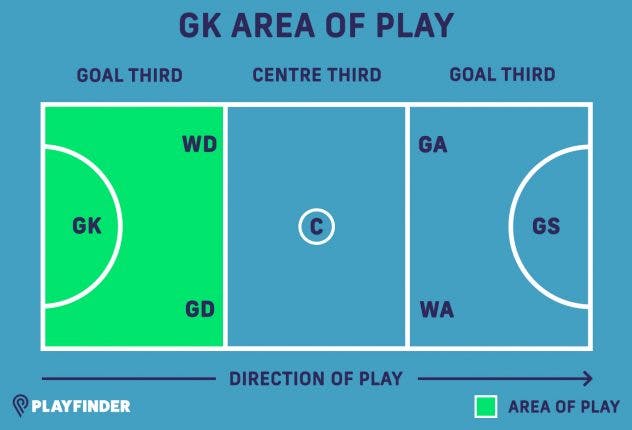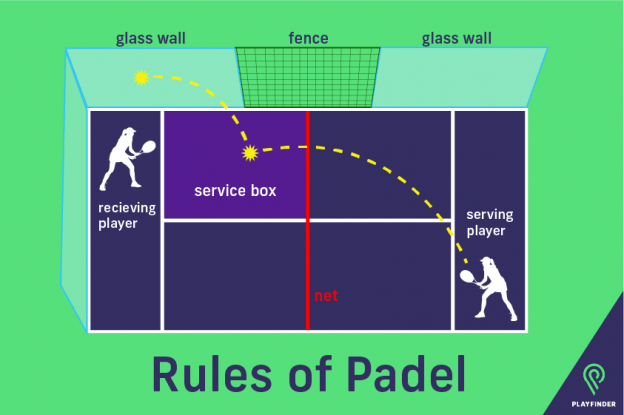Netball Rules and Positions | How to Play Netball
16 July 2019 • By - Emilie Adib
Getting into netball for the first time or coming back to the court and need a refresher? Check out our beginner’s guide to netball rules and positions.
Terms in bold are defined in the netball glossary at the end of this page.
Netball Positions
In a standard game of netball, a team has 7 players on court at one time. They take up the following positions:
| Goal Keeper | Allowed in the defensive goal third and shooting circle |
| Goal Defence | Allowed in the defensive and centre thirds, and the shooting circle |
| Wing Defence | Allowed in the defensive and centre thirds, but not the shooting circle |
| Centre | Allowed in all thirds, but not in either shooting circle |
| Wing Attack | Allowed in the attacking and centre thirds, but not the shooting circle |
| Goal Attack | Allowed in the attacking and centre thirds, and the shooting circle |
| Goal Shooter | Allowed in the attacking goal third and shooting circle |
See how they line up and which areas of the court each position is allowed to play in below:

Goal Keeper (GK)
Goal keepers are only allowed in their defensive goal third, including the shooting circle, in order to defend their goal. They primarily mark the opposing Goal Shooter (GS).

Goal Defence (GD)
A Goal Defence is allowed in both the centre third and their defensive third, including the shooting circle. They primarily mark the opposition team’s Goal Attack (GA).

Wing Defence (WD)
Like a GD, a Wing Defence is allowed in the centre and defensive thirds, however they are not allowed in the shooting circle. They primarily mark the opposing Wing Attack (WA).

Centre (C)
A Centre is allowed in all three thirds of the netball court except for the shooting circles at either end of the court. They primarily mark the Centre of the other team.

Wing Attack (WA)
The Wing Attack is allowed in both the centre third and the goal third in the direction their team is shooting, however they are not allowed in the shooting circle and therefore are unable to shoot. They primarily mark the Wing Defence of the opposing team.

Goal Attack (GA)
The Goal Attack is allowed in both the centre third and the goal third that they are shooting towards, including the shooting circle. They are one of two players on a netball team allowed to shoot and score points. They primarily mark the opposing team’s Goal Defence.

Goal Shooter (GS)
Goal Shooters are only allowed in the attacking goal third, including the shooting circle. Along with the Goal Attack, they are the only other player allowed to shoot at the net to score for their team. They primarily mark the other team’s Goal Keeper.

Netball Rules
Now you know about all the positions, it’s time to learn the netball rules of play.
Objective
The objective of netball is to score more points than your opposition. This is achieved by scoring goals through the nets positioned at either end of the court. You get one point for every goal you score.
Match Structure
According to standard netball rules, matches are split into four quarters. Each quarter lasts 15 minutes (amateur matches may be shorter) with a 5 minute break between the 2nd and 3rd quarter (half time). The teams switch ends after each quarter.
Match start and restart
The match starts with a centre pass, which is taken by the Centre in the centre circle. Other than the opposing Centre, all players must start in either their defensive or attacking goal third, defending on their position e.g. a Goal Defence must start the match in their defensive goal third.
When the umpire blows the whistle to signify the start of play, the Centre will attempt to pass the ball to a teammate. The ball must be caught in the centre third. If a player receives the ball in the goal third without it being touched in the centre third, the other team is awarded a free pass.
After a goal is scored, players return to their starting positions and another centre pass is taken. The teams take alternate centre passes, regardless of which team has just scored.
Footwork and passing the ball
When a player in is possession of the ball, in accordance with the netball rules, they must pass to a teammate or shoot within 3 seconds. If they fail to do this, the ball goes to the other team for a free pass. This is referred to as a held ball.
Players are also not allowed to throw the ball from one goal third to the other goal third without it being touched in the centre third. This results in a free pass for the other team.
As well as the three-second rule, players aren’t allowed to replant their landing foot if they choose to raise it from the ground. This means that they can take one step with their free leg and raise their landing foot off the ground, however they must pass the ball or shoot before their foot touches the ground again. Players are also able to pivot with their free foot to manoeuvre into a better passing position. The other team gets a free pass if a player replants their landing foot. This is referred to as footwork.
Shooting
Goal Attack (GA) and Goal Shooter (GS) are the only players allowed to shoot and score goals. Shots must be taken within the shooting circle, sometimes referred to as the D or semi-circle. The ball must pass through the net from above for a goal to be awarded. When a goal is awarded, play restarts with a centre pass.
Obstruction and contact
According to netball rules, the sport is not strictly a non-contact sport, however contact is only allowed when not impeding an opponent or general play. When a player is in possession of the ball, their opponent must stand at least three feet away from them when marking. If the player is impeded, an obstruction is called and the offending player must stand ‘out of play’ while a penalty pass or shot is taken.
A player can decide to carry on with their pass or shot while being obstructed by their opponent if they think they will gain an advantage. If they complete a successful pass or shot, the umpire will play advantage and play will continue. If the pass/shot is unsuccessful, the umpire will stop play and bring it back for a penalty pass or shot.
Offside
When a player retrieves the ball in an area of the court they’re not allowed to be in (e.g. the Centre catching the ball in the shooting circle) this is referred to as offside. A free pass is awarded to the opposition team for an offside call.
While a player may not be allowed to enter a certain area, they may lean on the ball in that area. This is deemed legal as long as no part of their body touches the ground in the area.
Throw ins
When the ball goes out of play, a throw in is awarded against the team that touched it last. This is taken in the spot where the ball went out of play. For the ball to be deemed out of play, it must make contact with the ground or a player positioned outside the area of the court.
Netball Rules Glossary
- Advantage – Advantage is played when a player decides to carry on play despite being impeded by an opposing player. The umpire will allow play to continue if they feel that stopping play and bringing it back for a penalty pass will give the impeded player a disadvantage.
- Attacking goal third – The attacking goal third is the third of the court that a team is shooting towards. Centres, Wing Attacks, Goal Attacks, and Goal Shooters are allowed in this third.
- Defensive goal third – The defensive goal third is the third of the court that a team is defending. Centres, Wing Defences, Goal Defences, and Goal Keepers are allowed in this third.
- Centre circle – The centre circle is a small circle in the middle of the court that the Centre must throw the ball from at the beginning of the match and from every centre pass.
- Centre pass – A centre pass is taken from the centre circle by the Centres of each team. They may pass the ball to their Goal Attack, Wing Attack, Wing Defence, or Goal Defence. The ball must be received in the centre third.
- Centre third – The centre third is the middle third of the court. All players apart from Goal Shooters and Goal Keepers are allowed in this third.
- Contact – Contact is called when a player impedes an opponent in a way that prevents them from moving freely. This includes knocking or hitting another player, or attempting to touch the ball while the other player has it. A penalty pass is award to the opposing team.
- Footwork – Footwork is called when a player moves and replants their landing leg. The other team is awarded a free pass in the position where the footwork took place.
- Free pass – A free pass is awarded to the opposing team when a player commits a non-contact infringement e.g. footwork or offside. If a free pass is awarded in the shooting circle to the attacking team, they may only pass the ball, not take a shot.
- Held ball – A held ball is when a player holds onto the ball for more than 3 seconds before passing or shooting. The other team is awarded a free pass.
- Landing foot – Your landing foot is the first foot you land on when you have jumped to receive the ball, meaning you are unable to move and reground it before passing the ball. If you catch a ball with both legs planted, the foot you decide not to move becomes your landing foot.
- Obstruction – Obstruction is called when a player marks the player with the ball at a distance shorter that 3 feet away. A penalty pass or shot is awarded to the opposition.
- Offside – Offside is called when a player receives the ball in an area of the court that they aren’t allowed to enter. A free pass is awarded to the opposition.
- Penalty pass/shot – A penalty pass is awarded when an obstruction or contact call is given by the umpire. If the penalty is awarded in the shooting circle for the attacking team, they may take a penalty pass or shot.
- Shooting circle – The shooting circles are the semi-circles (or Ds) at either end of the court. Only the Goal Keeper, Goal Defence, Goal Attack, and Goal Shooter are allowed in this area. Shots can only be taken within this area.
- Throw in – A throw in is taken when the ball goes off court. Throw ins are awarded against the team that touched the ball last, and must be taken from off the court.
- Umpire – The umpires maintain the netball rules by awarding free or penalty passes and keeping track of the score. They also signify pauses and restarts in play. Most netball matches have two umpires.
Now you know the netball rules and positions, you’re ready to give it a try. Book your nearest court through Playfinder, with netball courts available across the UK.




